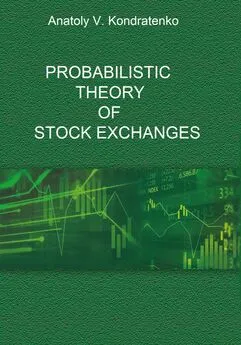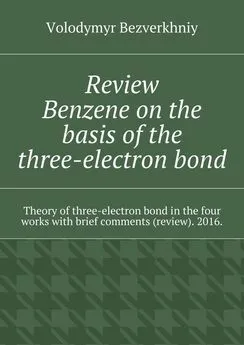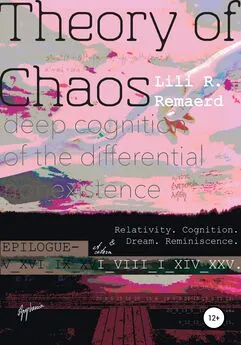Anatoly Kondratenko - Probabilistic Theory of Stock Exchanges
- Название:Probabilistic Theory of Stock Exchanges
- Автор:
- Жанр:
- Издательство:неизвестно
- Год:2022
- ISBN:нет данных
- Рейтинг:
- Избранное:Добавить в избранное
-
Отзывы:
-
Ваша оценка:
Anatoly Kondratenko - Probabilistic Theory of Stock Exchanges краткое содержание
Probabilistic Theory of Stock Exchanges - читать онлайн бесплатно ознакомительный отрывок
Интервал:
Закладка:
Anatoly Kondratenko
Probabilistic Theory of Stock Exchanges
To my beloved parents Vasily Denisovich and Alexandra Vasilievna Kondratenko with appreciation and gratitude
PREFACE
This is the third monograph in a series devoted to the development of probabilistic economic theory [Kondratenko, 2005, 2015, 2021]. When the first book was being prepared for publication, the publisher asked the author how soon, in the author’s opinion, this new theory would gain widespread acceptance among economists. His answer was: at the very least 20 years, for the simple reason that it is a priori not enough to put forward another alternative economic theory – first, it is necessary to show its benefits as compared to the others, second – to prove that it is correct, and third – to showcase how it can be used in practice to describe experimental data and develop predictions of economic dynamics. This monograph addresses all three of these issues: it shows how this theory is better than others; it proves, by the example of important organized markets such as stock exchanges, that it is correct; and, based on the analytical and numerical results obtained, it offers a method for describing and forecasting economic dynamics.
It is explained below why stock markets were chosen as the main object of study. It is well known that specialized activities of goods exchange or trade between different producers and different countries plays an eminent role in the growth of the welfare of individuals and states as a whole in the early stages of its development, and then in the subsequent rapid formation and development of capitalism in the world. In this process, the most important place was first occupied by ordinary markets, which facilitated and thus accelerated the process of exchange of some goods or values for others, and then by organized markets, the highest form of which are, in particular, stock exchanges: commodity, financial, currency and others, which form and represent in their entirety the stock exchange economy. This exchange economy is now effectively using all the most advanced methods and tools of electronic trading, including artificial intelligence and algorithmic trading using computers; while the extensive use of the Internet makes the exchange economy very fast, virtual and truly global. It is the high speed of information exchange and transactions that distinguishes the new virtual exchange economy from the traditional real economy. But this specific feature of exchange trading can carry additional risks for both the exchange and the real economy, the tasks of which are still rather superficially understood in the economic academic community. In today's global economic world, the role of stock exchanges has become so significant that it would not be an exaggeration to say that the entire global economy is gradually becoming exchange-based. For sure, it would be more accurate to talk about the transformation of the global economy into a financial economy, but this monograph will be focused on studying only the role of exchanges in the economy, so the term “exchange economy” will be used. The main purpose of exchanges in today's economy is to determine the prices of all traded assets, including various money (currencies), to facilitate their trade and provide financing for the global economic activity. But it is also important that the situation in exchanges is the most universal indicator of the situation in the entire global economy. The paradox of this situation in this global financial world is that there is clearly no correlating situation in the world of theoretical finance. An adequate theory of organized financial markets still does not exist, which means that an adequate theory of the global market real economy is also out of question. This situation gives rise to certain risks of the emergence and uncontrolled development of negative trends in financial markets, which can lead to large-scale financial and then economic crises. And that’s what we regularly observe in real life: the generator of almost all economic crises in modern history are financial crises triggered by a stock market crash.
Currently, the situation is aggravating and the risks are increasing due to the fact that the bulk of transactions are now carried out by computers, working strictly according to algorithms, aimed mainly at achieving quick results without even minimal losses, and acting almost simultaneously, which can cause a chain collapse at stock exchanges uncoupled from the actual situation in the economy and the real value of assets. Meanwhile, the regulators do not have any meaningful and reliable tools for controlling and managing particularly explosive situations in financial markets, especially in organized markets or stock exchanges, where the prices of all global commodities and assets are largely determined. Such regulating agencies currently use accumulated historical experience and empirical parametric models to develop their management processes [Intriligator, 2002]. For these reasons, overcoming the apparent stagnation in the development of theoretical finance is a long overdue global task. The main challenge here and now is the almost complete absence of a mathematical apparatus with a potential to be used not only describe the exchange functioning as an asset pricing mechanism, which is done by financial econometrics at a qualitative level, but also accurately calculate the temporal fine price structure and the temporal fine structure of the trade volume during short time intervals, for example, during one trading session. Using the analogy with the scattering theory in physics, this can be formulated the other way around. Econometrics solves the so-called inverse problem, namely, extracting information about the studied system from the experimental data. The present study, however, aims at solving a direct problem – creating a fairly universal method for ab initio calculation of the exchange time microstructures with a characteristic size of a few seconds, which can be directly compared with the corresponding experimental fine structures of time trading dynamics, a method that could serve as a powerful tool for building a general theory of exchanges. We hope that the probabilistic theory of stock exchanges developed in this study can serve as a basis for building a general probabilistic financial theory and a deeper understanding of how the global world of finance works.
Obviously, organized markets are complex multiagent non-equilibrium probabilistic systems, and their description requires adequate mathematical methods. At the moment, the only suitable source of such methods is, of course, physics, which has long accumulated experience in theoretical work with similar multiparticle systems. Besides, quite a lot of experience has already been accumulated with regard to the physical methods application in economics, i.e., the use of formal methods and approaches of theoretical physics to solve economic problems. In particular, in the works of A.V. Kondratenko [2005, 2015] a new theory of market economy – Probabilistic Economic Theory – was developed. Initially, this theory was based on quantum mechanics with the derivation of economic equations of motion, which have not yet been solved for multiagent markets. Subsequently, a simpler version of the theory was developed using the probabilistic method, namely – probability economy or probabilistic economics, which was used as the basic theory to develop the probabilistic theory of the exchange in this paper, although it does not have motion equation, but has a mathematical framework, which proved very adequate and viable for the description of exchange processes and structures. To be on the safe side and avoid misunderstandings, let us clarify that there is literally no physics in this theory, no mechanics, let alone quantum mechanics. It is an economic theory to describe the economic processes that take place in the stock exchange. It simply adapts to economics mathematical tools that were created hundreds of years ago and were previously successfully used to solve similar problems in physics.
Probabilistic economics can be seen as a theory developed in the manner of general ideology as a physical method in economics, as well as in classical economic theory, understanding it as a version of the economic theory development, which can be figuratively described by an evolutionary trajectory: Adam Smith – Karl Menger – Ludwig von Mises. The works of these three great economists gave rise to the author's understanding of the essence and purpose of real economic science and the desire to develop their ideas and concepts by using the modern scientific probabilistic method of research. The primary task then was to create a mathematical apparatus or body equivalent to the physical method and use it to calculate specific real economic systems similar to how the same process worked in the history of the development and rapid rise of physical science, due to the creation of a powerful mathematical body, starting with the discovery of the equations of motion and differential calculus.
The probabilistic method has long been used in economic research at the empirical level using the basic formulas of probability theory. The use of this method in economics, by analogy with the quantum mechanics of physical systems [Kondratenko, 2005, 2015], has widely expanded the scope of our ideas about the modern economic world, generated a new probabilistic style of scientific economic thinking and created a new probabilistic dynamic picture of the modern economic world, alternative to traditional static ideas of mainstream economics, including neoclassical economics. This monograph essentially solves the problem of practical application of this approach to specific economic systems, namely stock exchanges, since we have enough input data for their quantitative study, i.e., supply and demand quotations, as well as relevant experimental data represented by market prices and trade volumes for theory verification.
Probabilistic economics, as well as many probabilistic theories in various fields of science, primarily in physics, for example, in statistical and quantum physics, is developed in terms of probability distributions. We emphasize that probability distributions are the very thing that forms the basis and language of a probabilistic, scientifically substantiated method for studying complex dynamic systems.
The possibilities of probabilistic economics methods to accurately describe real markets have been demonstrated earlier [Kondratenko, 2005, 2015] using examples of small model commodity economies. In this work the author, on the basis of probabilistic economics, aimed to create the foundations of the stock exchange theory, capable of filling the gaps described above in the modern theory of finance, the results of which will be in good agreement with the experimental stock exchange data. This goal was achieved. Let us specify that it is clear from general considerations that the microscopic theory developed in this study is devoted to the study of various stock exchange structures and processes at the level of exchange agents, and even more precisely – at the level of actions of individual exchange agents. The main purpose of microscopic theory is to describe the process of these structures’ formation based on the specific actions of the agents. First of all, this study will cover the mechanisms of exchange prices and trade volumes formation based on the quotations of market agents (in a particular period of time). It can be figuratively said that this theory gives a microscopic view of the stock exchange and stock exchange phenomena.
The book will show that probabilistic economics provides an adequate, fairly accurate micro- and macroscopic description of the stock exchange, namely, detailed structures and mechanisms of its operation, which were studied to derive certain patterns in the work of stock exchanges, in particular patterns in the prices and trade volumes formation.
Читать дальшеИнтервал:
Закладка:










